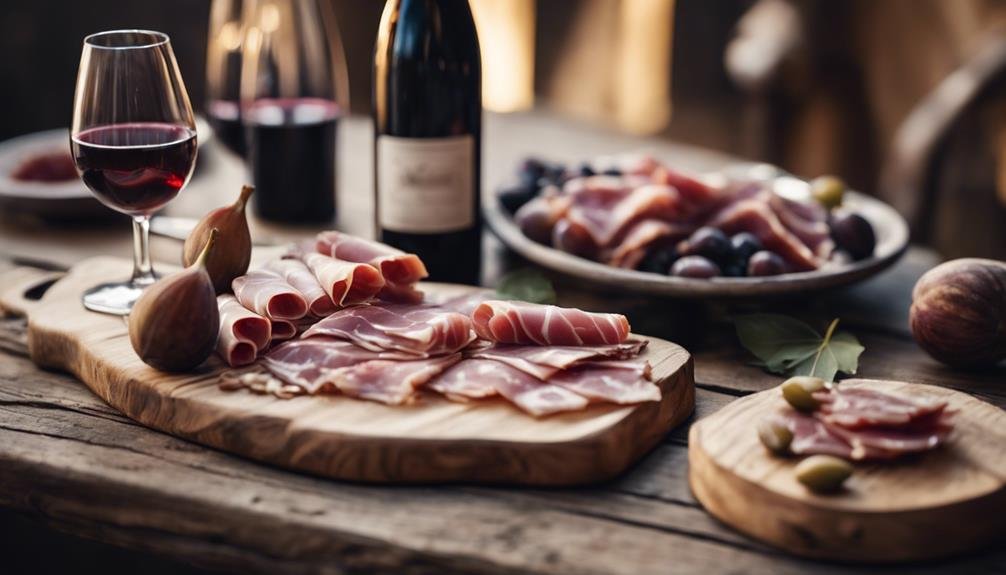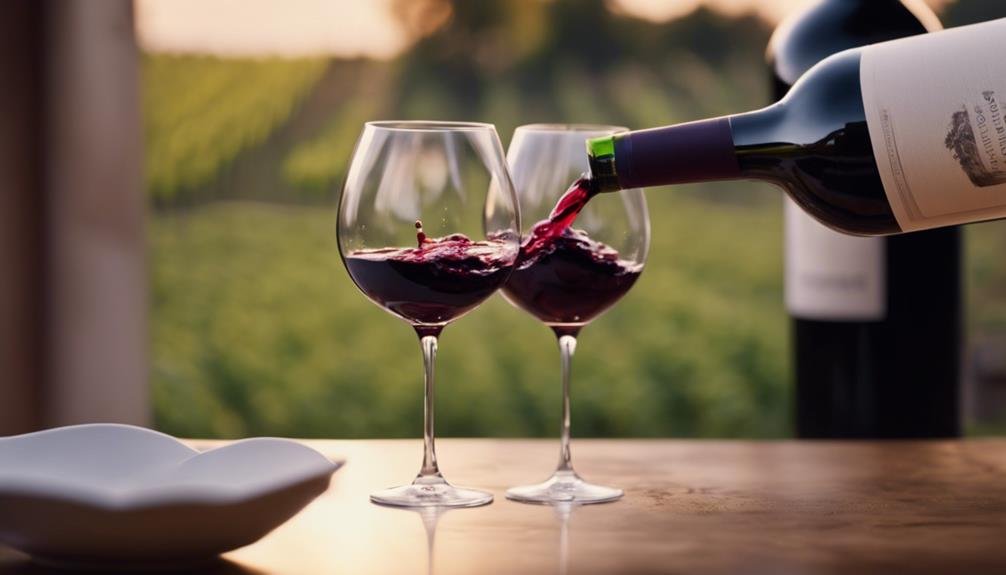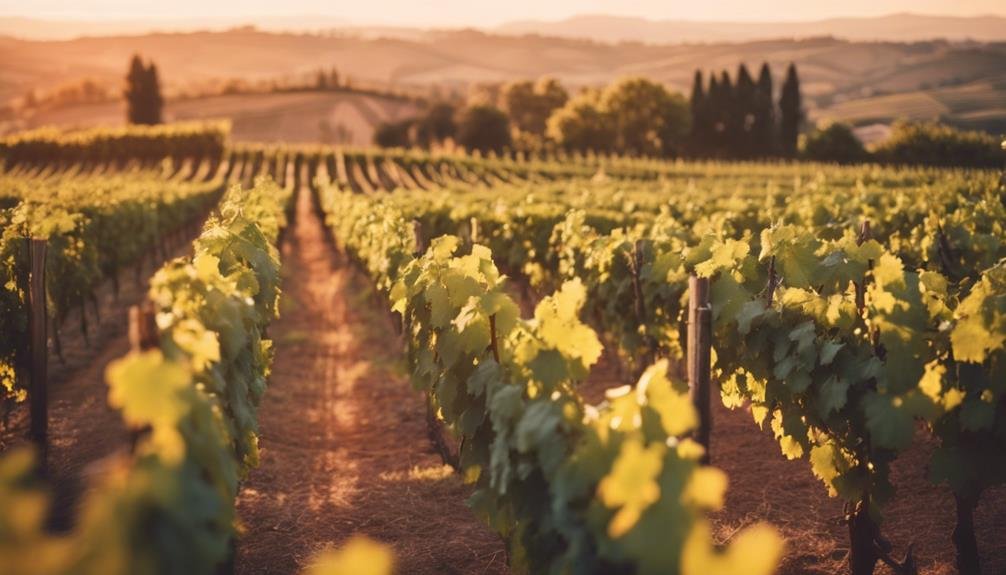Sangiovese wines offer a fascinating journey through their diverse characteristics. They age gracefully, evolving from cherry notes to dried cherries, figs, and roses. Each sip reflects the unique terroir where the grapes grow, providing a range of flavors and aromas. Sangiovese's adaptability to different environments results in enthralling complexities. Perfect pairings include herb-roasted chicken and Margherita pizza, enhancing the tasting experience. Globally, diverse climates influence flavor profiles, showcasing the grape's versatility. Wine experts praise Sangiovese's evolution over time, emphasizing its appreciation with aging. Explore further to uncover the rich tapestry of Sangiovese's world.
Sangiovese Wine Characteristics
Sangiovese wine characteristics encompass a diverse spectrum of flavors and aromas that reflect the grape's adaptability to different terroirs, alluring wine enthusiasts with a range from fruit-forward to earthy profiles.
This grape variety displays a remarkable aging potential, with its aromas evolving from cherry in youth to dried cherries, figs, and roses as it matures. The terroir influence on Sangiovese wines is profound, with different growing regions imparting distinct characteristics to the final product.
Sangiovese's ability to express the nuances of its environment makes it a captivating choice for wine lovers seeking complexity and depth. Understanding how terroir shapes Sangiovese wines can enhance appreciation for the varied expressions this grape offers, from vibrant and fruity to savory and earthy profiles.
Exploring Sangiovese Flavor Profiles
Delving into the intricate spectrum of flavors found in Sangiovese wines reveals a fascinating journey through diverse sensory experiences. Sangiovese wines exhibit a wide range of flavors influenced by factors such as aging potential and soil influences.
- Aging Potential: Sangiovese wines evolve with time, showcasing aromas that shift from fresh cherry notes to more complex dried cherries, figs, and roses as they mature.
- Soil Influences: The terroir in which Sangiovese grapes are grown plays a significant role in shaping the wine's flavor profile, with variations in soil composition contributing unique characteristics to the final product.
- Complexity in Every Sip: Each glass of Sangiovese offers a journey through layers of flavors, from vibrant fruits to earthy undertones, providing a truly enriching tasting experience.
Perfect Pairings for Sangiovese Wines

Exploring the diverse flavor profiles of Sangiovese wines naturally prompts thinking about ideal pairings that enhance the tasting experience. When considering food combinations for Sangiovese wines, it's important to match the wine's flavor profiles with complementary dishes. Here is a table to guide you:
| Sangiovese Flavor Profiles | Ideal Pairings |
|---|---|
| Fruit-forward | Herb-roasted chicken |
| Margherita pizza | |
| Caprese salad | |
| Rustic | Grilled lamb |
| Mushroom risotto | |
| Aged Parmesan cheese |
Pairing Sangiovese with these recommended foods will enhance the overall tasting experience by creating harmonious flavor combinations that complement each other.
Global Influence on Sangiovese Production
The global expansion of viticulture has greatly impacted the production and popularity of Sangiovese wines in recent years.
- Climate impact: Different climates influence the grape's characteristics, leading to diverse flavor profiles in Sangiovese wines.
- Grape diversity: The versatility of Sangiovese allows for different expressions based on the grape's diversity and adaptability to various terroirs.
- Emerging regions, unique expressions: As Sangiovese is planted in new regions around the world, winemakers are exploring innovative techniques, resulting in unique and exciting interpretations of this classic grape variety.
Wine Expert Insights on Sangiovese

Insights from wine experts shed light on the nuanced characteristics and evolving trends of Sangiovese wines in the contemporary wine industry.
When it comes to Sangiovese, various wine regions showcase the grape's versatility, from Tuscany's Chianti Classico to Montalcino and Montepulciano. These regions highlight the diverse expressions of Sangiovese, ranging from elegant and floral to robust and tannic.
Experts also emphasize the aging potential of Sangiovese, noting how the wine evolves with time, developing complex aromas of cherry, dried fruits, and spices. Understanding the aging potential allows wine enthusiasts to appreciate the evolution of Sangiovese and select bottles that align with their preferences.
Frequently Asked Questions
Can Sangiovese Wines Be Aged for Extended Periods?
Sangiovese wines can age well for extended periods, evolving in complexity. Peak aging potential varies by producer and vintage, with Brunellos and Chiantis often showing best results. Cellaring tips include storing in a cool, dark place.
Are There Any Vegan-Friendly Sangiovese Wine Options?
In exploring vegan-friendly Sangiovese wine options, consider food pairings that enhance the fruity flavors and savory character of the wine. Tasting notes may feature cherry aromas and grippy tannins. Production methods prioritize sustainability, ensuring minimal environmental impact.
What Is the Ideal Temperature to Serve Sangiovese Wines?
To serve Sangiovese wines at their best, aim for a temperature around 60-65°F. Perfect for food pairings, the medium-bodied wine complements tomatoes, herbs, roasted meats, and hard cheeses. Store at a consistent temperature in a wine cellar for optimal results.
Are There Any Sustainable or Organic Sangiovese Producers?
Biodynamic practices and sustainable vineyards are embraced by select Sangiovese producers. These conscientious vintners prioritize eco-friendly methods, ensuring the preservation of the environment while crafting exceptional wines. Seek out these esteemed estates for sustainable Sangiovese indulgence.
How Do Different Sangiovese Clones Affect the Wines Flavor?
Different Sangiovese clones impact flavor through grape varietals and terroir influence. Variations in wine production and fermentation techniques further shape taste profiles. Understanding these nuances allows for a deeper appreciation of the diverse expressions of Sangiovese wines.
Conclusion
In the vast world of wine, Sangiovese shines as a versatile and complex grape variety, offering a wide range of flavors and aromas.
From the floral notes of Montefalco Rosso to the tannic profile of Brunello di Montalcino, each glass of Sangiovese wine tells a unique story of its terroir and craftsmanship.
By exploring the characteristics, pairings, and global influence of Sangiovese, enthusiasts can deepen their appreciation and savor the rich tapestry of experiences this noble grape has to offer.
